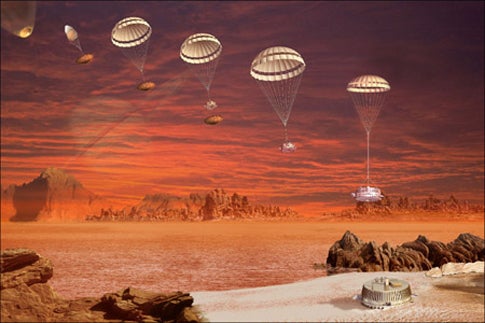Ever spilled your drink on an airline because of turbulence? Researchers on both sides of the Atlantic are finding new ways to understand the phenomenon-both in Earth’s atmosphere and in that of Saturn’s moon Titan, aided by data gathered from the Cassini-Huygens probe.
“Exactly the same physical processes are occurring on Titan and Earth, although under interestingly different conditions,” notes planetary scientist Ralph Lorenz, of the Johns Hopkins University Applied Physics Laboratory. “Scientists who look at the Earth and those who study other planets, working together, can gain new insights into both places.”
Turbulence is an important process in our weather, and can be more than an inconvenience — hundreds of injuries have occurred on commercial flights due to turbulence.
Giles Harrison, an atmospheric physicist in the Department of Meteorology at the University of Reading, devised an inexpensive way of measuring turbulence effects using weather balloons.
The instrument package — a radiosonde — measures Earth’s magnetic field to detect turbulent motion. In a paper subtitled “A Compass for a Radiosonde,” magnetic changes measured on the weather balloon were shown to arise from motions within cloud, using Earth’s stable magnetic field for reference.
Lorenz found Harrison’s results key to making sense of data from the Huygens probe, which descended by parachute through Titan’s atmosphere in January 2005. The Surface Science Package on board Huygens included tilt sensors that measured motions of the probe during its descent.
These tilt sensors act much like a drink in a glass, using a small slug of liquid to measure tilt angle. But as the probe plummeted at high speed on Titan, there was a lot of buffeting, even though the air itself was fairly still.
By knowing the particular signature of cloud-induced turbulence in Harrison’s Earth balloon data, where nearby weather radar could document what was causing the turbulence, Lorenz was able to find this signal at Titan despite the buffeting during the Huygens descent. “The Huygens tilt history was just this long squiggly complex mess, but seeing the fingerprint of cloud turbulence in Harrison’s work showed me what to look for,” he says.
Armed with that information, Lorenz found that a 20-minute period during Huygens’ 2.5-hour descent, around an altitude of 20 kilometers (about 12 miles), was affected by this kind of in-cloud turbulence.
Having experimented with instrumentation on small models, even Frisbees, to understand the dynamics of aerospace vehicles like the probe, Lorenz was familiar with the sensors Harrison used. His analysis helped identify a turbulent cloud layer in Titan’s atmosphere-a significant result for the investigation of Titan’s meteorology. In the process, he also found a way to improve Harrison’s magnetic sensor arrangement on the weather balloon, simply by changing its orientation.
“We went to Titan to learn about that mysterious body and its atmosphere,” he notes. “It’s neat that there are lessons from Titan that can be usefully applied here on Earth.”
Lorenz’s analysis was recently published online in the journal Planetary and Space Science, and an exchange of ideas between Lorenz and Harrison appears in the August 2007 issue of Journal of Atmospheric and Oceanic Technology.










